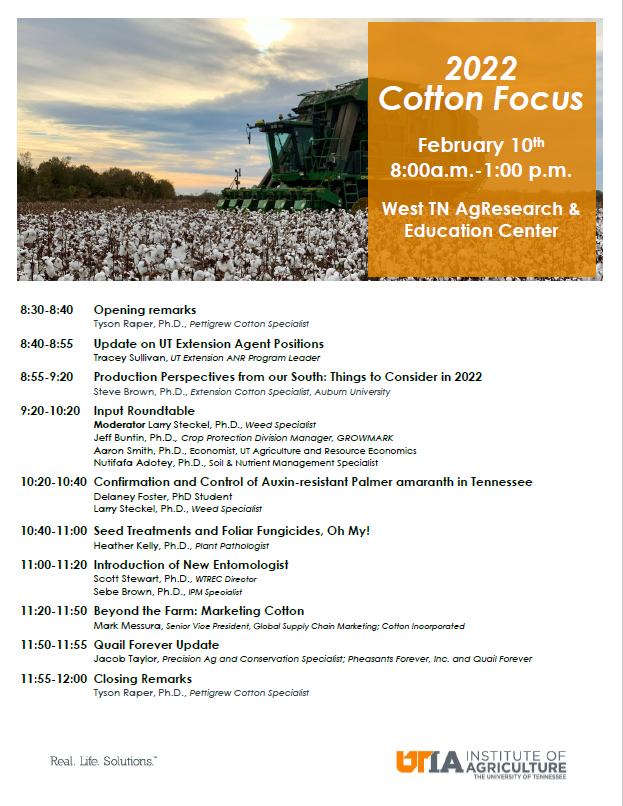We are quickly approaching the period of time in which we typically apply PGRs. Unfortunately, May was not kind and June has been dry. Many are struggling with figuring out when to start PGR applications and how aggressive we should be with that first application. In this blog, I link to our most recent Cotton Specialists’ Corner podcast on this very issue. This episode highlights several things to keep in mind before we run a stiff rate of PGR to an already stressed plant and potentially hurt yields.
All posts by Tyson Raper, Cotton & Small Grains Specialist
Ascochyta, herbicide burn, poor stand. . . do I replant it?
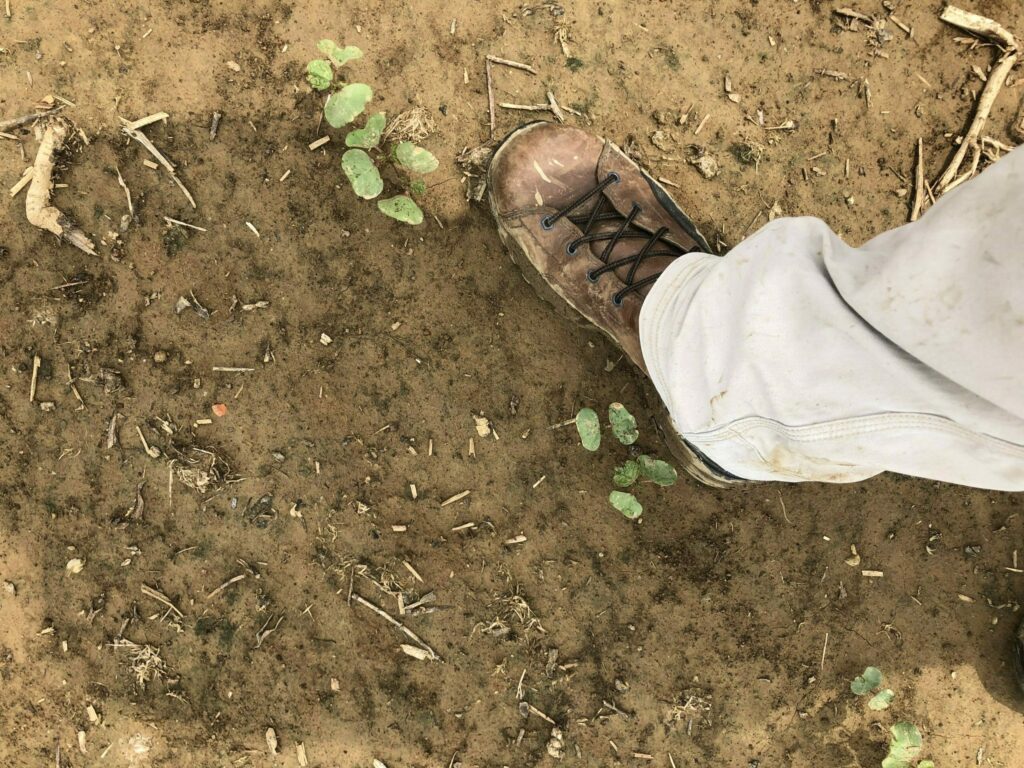 Large rainfall events and cool weather in late May strained Tennessee’s cotton crop. In some areas, individuals are considering replanting cotton that failed to emerge or cotton that appears to be just sitting. In other areas, reports of damaged or desiccated cotyledons have been reported and healthy, large cotyledons are hard to find most anywhere. In this blog, I cover a few rules of thumb to consider when determining whether or not to keep the stand and give a few words of advice to those that are considering May 30-something cotton. Continue reading
Large rainfall events and cool weather in late May strained Tennessee’s cotton crop. In some areas, individuals are considering replanting cotton that failed to emerge or cotton that appears to be just sitting. In other areas, reports of damaged or desiccated cotyledons have been reported and healthy, large cotyledons are hard to find most anywhere. In this blog, I cover a few rules of thumb to consider when determining whether or not to keep the stand and give a few words of advice to those that are considering May 30-something cotton. Continue reading
Making the decision to replant and assessing injury from hail
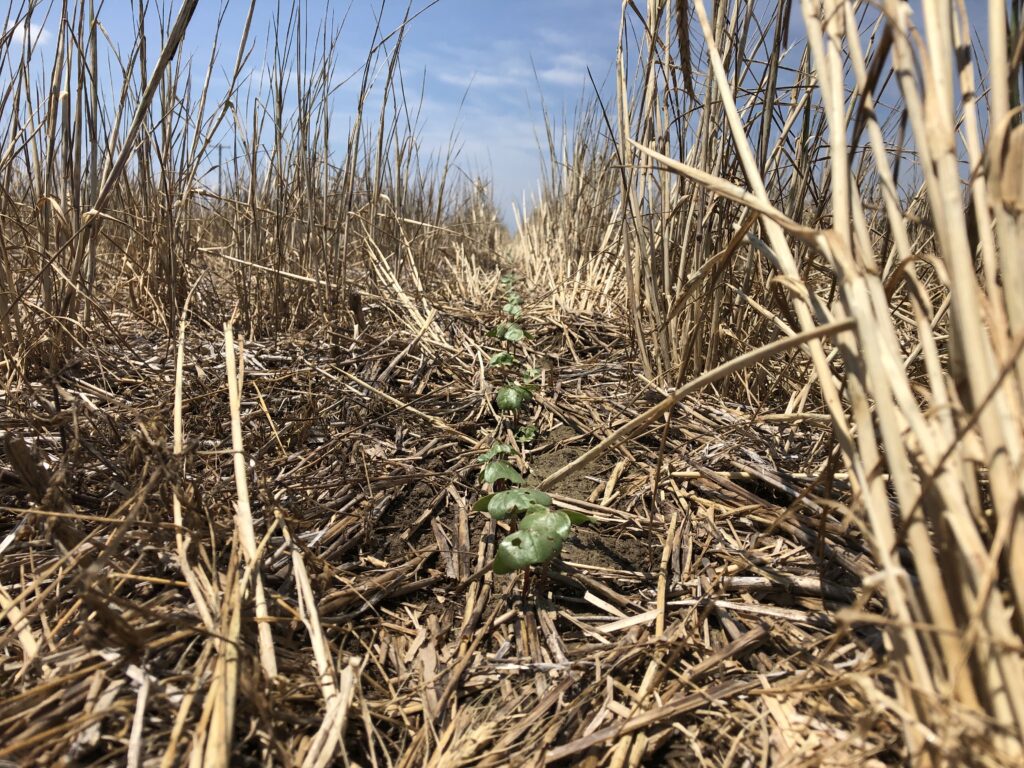 Strong thunderstorms brought heavy rainfall and isolated hail to some areas of the MidSouth last weekend (5/13-5/15). Reports of hail damage have not been widespread and many welcomed a rather helpful rainfall event. Still, those who caught hail are assessing their damaged stand and those who caught the heaviest rainfalls are trying to determine if a replant is warranted. In this blog, I summarize some recent research conducted by the MidSouth Cotton Specialists’ Working Group on hail damage and planting date/populations and discuss the applicability of those findings to our current situation. Continue reading
Strong thunderstorms brought heavy rainfall and isolated hail to some areas of the MidSouth last weekend (5/13-5/15). Reports of hail damage have not been widespread and many welcomed a rather helpful rainfall event. Still, those who caught hail are assessing their damaged stand and those who caught the heaviest rainfalls are trying to determine if a replant is warranted. In this blog, I summarize some recent research conducted by the MidSouth Cotton Specialists’ Working Group on hail damage and planting date/populations and discuss the applicability of those findings to our current situation. Continue reading
Thoughts on our last planting window and the next one to come
 The Extension Cotton Specialists’ Working Group, with funding from Cotton Inc and support from a number of seed companies, has been studying seed quality and the impacts marginal seed have on in-season performance since 2020. I planted the 2022 seed quality trial last Thursday (April 28th) with the expectation that even the best treatments would struggle, based on the forecast. To my surprise, each time I checked the forecast temperatures increased and rain chances shrunk. Some of those treatments emerged yesterday and they rowed this afternoon (pictured above). The planting window that I thought would help separate excellent seed from marginal seed just might make everything look great! Continue reading
The Extension Cotton Specialists’ Working Group, with funding from Cotton Inc and support from a number of seed companies, has been studying seed quality and the impacts marginal seed have on in-season performance since 2020. I planted the 2022 seed quality trial last Thursday (April 28th) with the expectation that even the best treatments would struggle, based on the forecast. To my surprise, each time I checked the forecast temperatures increased and rain chances shrunk. Some of those treatments emerged yesterday and they rowed this afternoon (pictured above). The planting window that I thought would help separate excellent seed from marginal seed just might make everything look great! Continue reading
National Cotton Council Trust Protocol Seminar + Lunch, March 25th @ WTREC
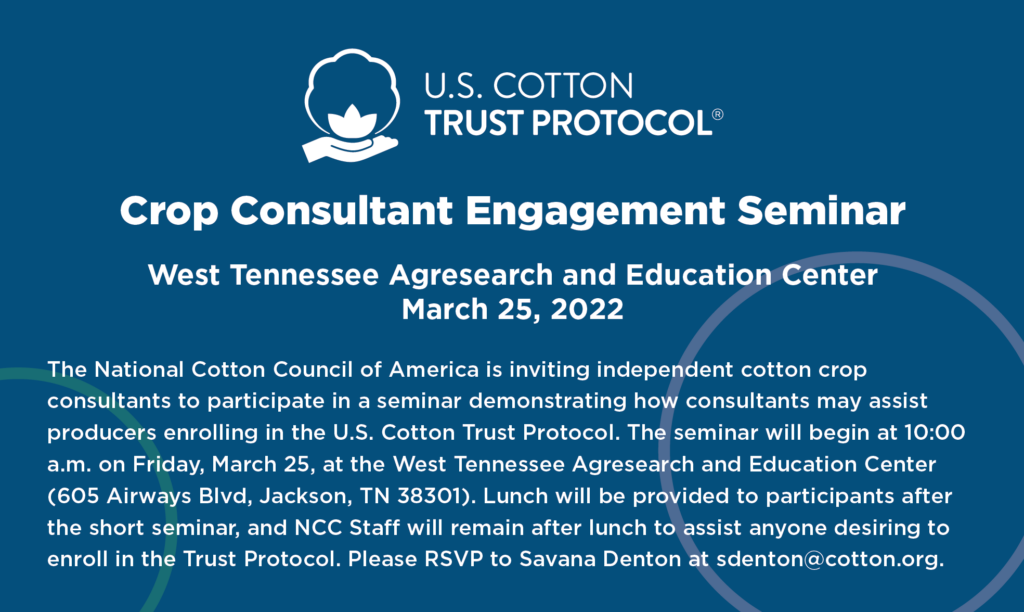 The National Cotton Council is seeking engagement from cotton crop consultants to help facilitate the enrollment of cotton producers in the U.S. Cotton Trust Protocol. The Trust Protocol is an industry-led sustainability initiative that proves, measures, and verifies the sustainability of U.S. cotton. This seminar will provide information and benefits regarding the Trust Protocol so that you as the consultant can assist your producer with the enrollment process. Cotton producers are invited and encouraged to attend as well to learn more about the Trust Protocol and enroll. Consultants have the ability to enroll in the Trust Protocol and then, once linked with their enrolled producer, can enter field level information on behalf of the producer. Complete enrollment in the Trust Protocol prior to the end of March will allow producers to enroll their 2021 crop data and bales.
The National Cotton Council is seeking engagement from cotton crop consultants to help facilitate the enrollment of cotton producers in the U.S. Cotton Trust Protocol. The Trust Protocol is an industry-led sustainability initiative that proves, measures, and verifies the sustainability of U.S. cotton. This seminar will provide information and benefits regarding the Trust Protocol so that you as the consultant can assist your producer with the enrollment process. Cotton producers are invited and encouraged to attend as well to learn more about the Trust Protocol and enroll. Consultants have the ability to enroll in the Trust Protocol and then, once linked with their enrolled producer, can enter field level information on behalf of the producer. Complete enrollment in the Trust Protocol prior to the end of March will allow producers to enroll their 2021 crop data and bales.
Join us on March 25th at 10AM at the West Tennessee AgResearch and Education Center (605 Airways Blvd. Jackson, TN 38301). Lunch will be provided and NCC staff will be present to aid in Trust Protocol enrollment. Please RSVP to Savana Denton at sdenton@cotton.org. Hope to see you there!
Overcoming the Timber Harvest Blues: Out of the rubble will come renewal
Over the past several months, those that drive by the ‘Experiment Station’ in Jackson have noted big changes on the farm. In July of 2021, it was difficult to see more than a few hundred yards across the north side of the station from the 45 bypass. Now, from the bypass, you can almost see traffic on Airways Blvd.
As a row crops blog, we rarely dive into subjects outside of those directly related to corn, soybean, cotton or wheat. Subsequently, we rarely include content on the blog from one of our most well known and best Extension Specialists, Dr. Dave Mercker. Dr. Mercker serves as our Extension Forester and is world-renowned; he has been named a Fellow by the Society of American Foresters and was named the 2020 Extension Forester of the year by the Forest Landowners Association. Dr. Mercker recently completed an outstanding publication covering the process of ‘recovery’ after timber harvest. Dr. Mercker has graciously written a brief history of the West TN REC timber stand for this blog and included a link to the Extension pub I mentioned above at the end of this article. I am certain you will find both of these very informative and will likely have reason to reference Dr. Mercker’s publication on your own farm. You’ll also find a brief video highlighting the WTREC timber harvest by Julia Ewoldt above. Continue reading
Reminder – 2022 UT Cotton Focus, Thursday, Feb 10
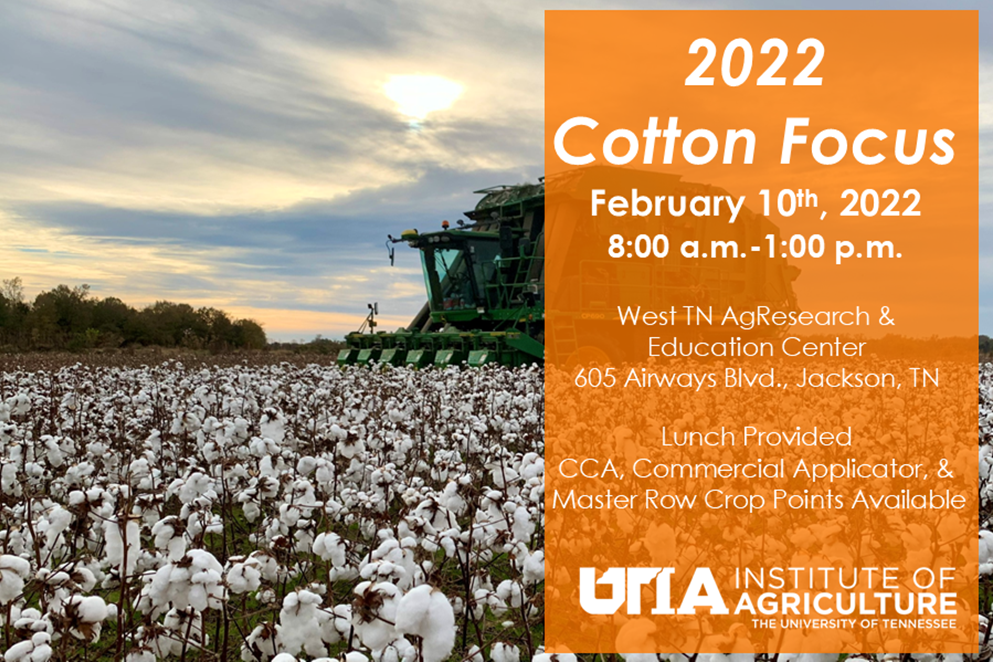
The 2022 University of Tennessee Cotton Focus is coming up on February 10th from 8AM to 1PM in Jackson, TN at the West Tennessee Research and Education Center (605 Airways Blvd Jackson, TN 38301). Lunch will be provided and CCA, Commercial Applicator and Master Row Crop Points will be available. S&J’s Roadside will be catering lunch.
This is an event you will not want to miss! We have several excellent guest speakers that will provide very valuable insight into several important decisions that we will have to make during 2022. We look forward to seeing you there.
Cotton Focus coming up February 10th

The 2022 University of Tennessee Cotton Focus is coming up on February 10th from 8AM to 1PM in Jackson, TN at the West Tennessee Research and Education Center (605 Airways Blvd Jackson, TN 38301). Lunch will be provided and CCA, Commercial Applicator and Master Row Crop Points will be available.
I will be posting the final agenda next week, but I can promise you will not want to miss this year’s content! We have several speakers that will be addressing extremely impactful information that will help tackling the challenges of 2022. Hope to see you there!

